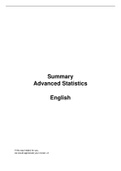Samenvatting
Full Summary Advanced Statistics (AY), UvA English
- Instelling
- Universiteit Van Amsterdam (UvA)
- Boek
- Multiple Regression
A comprehensive summary of the course Advanced Statistics (in English) with a table of contents at the front to keep the overview. All given chapters are summarised and so are all lectures, tutorial videos and writing tutorials.
[Meer zien]





